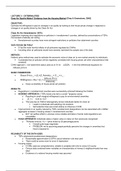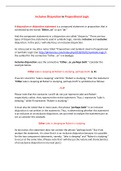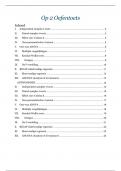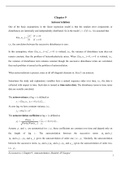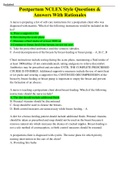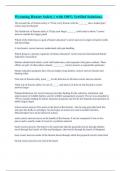LECTURE 3 – EXTERNALITIES
Does Air Quality Matter? Evidence from the Housing Market [Chay & Greenstone, 2005]
OBJECTIVE:
Estimate the willingness to pay for changes in air quality by looking at how house prices change in response to
changes in air quality driven by the Clean Air Act
Clean Air Act Amendments (1970):
Legislation imposing strict regulations on polluters in ‘nonattainment’ counties, defined by concentrations of TSPs
that exceed a federally set ceiling
Nonattainment counties have more stringent restrictions on polluters than attainment counties
WHY FOCUS ON TSPs?
It had the most harmful effects of all pollutants regulated by CAAAs
Including other air pollutants would have severely restricted the sample size of the data
METHOD:
Hedonic price method was used to estimate the economic value of clear air (a nonmarket amenity) to individuals
It predicted that air pollution will be negatively correlated with housing prices (all other characteristics held
constant)
CAAA approach = nonattainment status used as an IV for ΔTSPs in the first differenced equations for
Δ house prices
BASIC FRAMEWORK:
House Price a ,t =β 0+ β1 Amenity a ,t + X a ,tγ + ε a , t
ΔHouse Price
Willingness¿ Pay=β 1=
ΔAmenity
o Gives us elasticity of house prices wrt pollution
RESULTS:
Regulations in nonattainment counties were successfully enforced following the CAAAs
HEDONIC APPROACH: TSPs levels only led to a small property values
o Resulting in small marginal willingness to pay for environmental amenities
o β 1=¿ 0.04 to 0.07
o This was due to OVB & heterogeneity across individuals tastes for clean air
Leads to individuals selfselecting into locations
Selfselection bias was small relative to influence of OVB
Improvements in air quality induced by TSPs nonattainment designations can be associated with a $45bn
aggregate increase in housing values in nonattainment counties
o BUT net welfare effect is unknown since reliable estimates of social costs/regulations are
unavailable
CAAA APPROACH: Individuals place a higher value on clean air than previously recognised
o Pollution level by 1% = price levels by 36 percentage points
Overall quite large magnitude
PROBLEM: we’re assuming people perfectly perceive the changes in amenities that
they’re exposed to
RELIABILITY OF THE DATA USED:
TSPs attainment/nonattainment designations:
o Reasonable approximation to EPA’s actual selection rule was used
o There could be some room for error & imprecision
Housing values:
o CCDBs used are comprehensive, reliable & complete with info for every US county
o Census data contained fewer variables on characteristics of homes & neighbourhoods than was
ideal
o Existence of a national housing market was assumed
, Unable to explore the degree of withincounty taste heterogeneity & sorting
Could lead to results understating individuallevel dispersion in MWTP
o Income & other similar variables are generally excluded
Direct test of validity of exclusion restriction unavailable
o Hedonic approach was original an individual level model
Aggregation to county level may induce some biases
LECTURE 4 – PUBLIC GOODS [Gneezy, Uri and Rustichini, 2000]
A Fine is a Price
THE STUDY:
10 daycare centres were observed over 20 weeks (Israel, 19911992)
In the 1st 4 weeks only the no. parents who arrived late were observed
Beginning of 5th week a monetary fine was introduced to 6 daycare centres on those who arrived 10+
mins late (other 4 daycare centres served as a control group)
o The fine of NIS 10 was relatively small but not insignificant
Beginning of 7th week the fine was removed
METHOD:
Control: initial 4 weeks
Treatment group was selected randomly
o There was no significant difference in the behaviour of the test group & control group in the initial 4
weeks
o No significant trend in the test group in the initial 4 weeks
All daycare centres were located in the same part of town with no important differences among them
RDD exogenous variation from average class size falling after every multiple of 40
THE RESULTS:
The no. latecoming parents increased significantly after the fine was introduced
o Almost doubled in the level of the rate of delay
At the end of the adjustment period after the fine was introduced (lasting 23 weeks) the no. late coming
parents remained stable @ a higher rate than in the nofine period
After the fine was removed no reductions occurred in the level of the rate of delay for the treatment group
The results contradicted the deterrence hypothesis
o Deterrence hypothesis: predicts that the introduction of a penalty that leaves everything else
unchanged will reduce the occurrence of the behaviour subject to the fine
INTERPRETATION OF RESULTS:
The results contradicted the deterrence theory for 2 possible reasons:
o A “large enough” fine would eventually reduce the behaviour
o The introduction of a fine can change the perception of the obligation to arrive on time
∴ The assumption that “everything else is left unchanged” didn’t hold
Contract was previously incomplete parents didn’t know how bad it was to be late (as
there was no price on being late)
Intrinsic motivation for being a good person is removed
o People don’t want to seem greedy for money
Does Air Quality Matter? Evidence from the Housing Market [Chay & Greenstone, 2005]
OBJECTIVE:
Estimate the willingness to pay for changes in air quality by looking at how house prices change in response to
changes in air quality driven by the Clean Air Act
Clean Air Act Amendments (1970):
Legislation imposing strict regulations on polluters in ‘nonattainment’ counties, defined by concentrations of TSPs
that exceed a federally set ceiling
Nonattainment counties have more stringent restrictions on polluters than attainment counties
WHY FOCUS ON TSPs?
It had the most harmful effects of all pollutants regulated by CAAAs
Including other air pollutants would have severely restricted the sample size of the data
METHOD:
Hedonic price method was used to estimate the economic value of clear air (a nonmarket amenity) to individuals
It predicted that air pollution will be negatively correlated with housing prices (all other characteristics held
constant)
CAAA approach = nonattainment status used as an IV for ΔTSPs in the first differenced equations for
Δ house prices
BASIC FRAMEWORK:
House Price a ,t =β 0+ β1 Amenity a ,t + X a ,tγ + ε a , t
ΔHouse Price
Willingness¿ Pay=β 1=
ΔAmenity
o Gives us elasticity of house prices wrt pollution
RESULTS:
Regulations in nonattainment counties were successfully enforced following the CAAAs
HEDONIC APPROACH: TSPs levels only led to a small property values
o Resulting in small marginal willingness to pay for environmental amenities
o β 1=¿ 0.04 to 0.07
o This was due to OVB & heterogeneity across individuals tastes for clean air
Leads to individuals selfselecting into locations
Selfselection bias was small relative to influence of OVB
Improvements in air quality induced by TSPs nonattainment designations can be associated with a $45bn
aggregate increase in housing values in nonattainment counties
o BUT net welfare effect is unknown since reliable estimates of social costs/regulations are
unavailable
CAAA APPROACH: Individuals place a higher value on clean air than previously recognised
o Pollution level by 1% = price levels by 36 percentage points
Overall quite large magnitude
PROBLEM: we’re assuming people perfectly perceive the changes in amenities that
they’re exposed to
RELIABILITY OF THE DATA USED:
TSPs attainment/nonattainment designations:
o Reasonable approximation to EPA’s actual selection rule was used
o There could be some room for error & imprecision
Housing values:
o CCDBs used are comprehensive, reliable & complete with info for every US county
o Census data contained fewer variables on characteristics of homes & neighbourhoods than was
ideal
o Existence of a national housing market was assumed
, Unable to explore the degree of withincounty taste heterogeneity & sorting
Could lead to results understating individuallevel dispersion in MWTP
o Income & other similar variables are generally excluded
Direct test of validity of exclusion restriction unavailable
o Hedonic approach was original an individual level model
Aggregation to county level may induce some biases
LECTURE 4 – PUBLIC GOODS [Gneezy, Uri and Rustichini, 2000]
A Fine is a Price
THE STUDY:
10 daycare centres were observed over 20 weeks (Israel, 19911992)
In the 1st 4 weeks only the no. parents who arrived late were observed
Beginning of 5th week a monetary fine was introduced to 6 daycare centres on those who arrived 10+
mins late (other 4 daycare centres served as a control group)
o The fine of NIS 10 was relatively small but not insignificant
Beginning of 7th week the fine was removed
METHOD:
Control: initial 4 weeks
Treatment group was selected randomly
o There was no significant difference in the behaviour of the test group & control group in the initial 4
weeks
o No significant trend in the test group in the initial 4 weeks
All daycare centres were located in the same part of town with no important differences among them
RDD exogenous variation from average class size falling after every multiple of 40
THE RESULTS:
The no. latecoming parents increased significantly after the fine was introduced
o Almost doubled in the level of the rate of delay
At the end of the adjustment period after the fine was introduced (lasting 23 weeks) the no. late coming
parents remained stable @ a higher rate than in the nofine period
After the fine was removed no reductions occurred in the level of the rate of delay for the treatment group
The results contradicted the deterrence hypothesis
o Deterrence hypothesis: predicts that the introduction of a penalty that leaves everything else
unchanged will reduce the occurrence of the behaviour subject to the fine
INTERPRETATION OF RESULTS:
The results contradicted the deterrence theory for 2 possible reasons:
o A “large enough” fine would eventually reduce the behaviour
o The introduction of a fine can change the perception of the obligation to arrive on time
∴ The assumption that “everything else is left unchanged” didn’t hold
Contract was previously incomplete parents didn’t know how bad it was to be late (as
there was no price on being late)
Intrinsic motivation for being a good person is removed
o People don’t want to seem greedy for money

